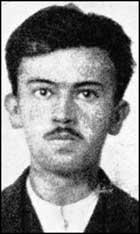Trifko Grabez

Trifko Grabez, the son of a Serb-Orthodox priest in Pale, a small town in Bosnia-Herzegovina about twelve miles east of Sarajevo, was born in 1895. At the age of seventeen Grabez was expelled from school for striking one of his teachers.
Grabez left home and moved to Belgrade, the capital of Serbia. As well as continuing his education he joined the Black Hand secret society. For the next two years he spent most of his spare time with other nationalists who favoured a union between Bosnia-Herzegovina and Serbia.
When it was announced that Archduke Franz Ferdinand, the heir to the throne of Austro-Hungarian Empire, was going to visit Bosnia-Herzegovina in June 1914, Dragutin Dimitrijevic, the chief of the Intelligence Department in the Serbian Army and head of the Black Hand, sent three men, Grabez, Nedjelko Cabrinovic and Gavrilo Princip to Sarajevo to assassinate him.
Each man was given a revolver, two bombs and small vial of cyanide. They were instructed to commit suicide after Archduke Franz Ferdinand had been killed. It was important to Dragutin Dimitrijevic that the men did not have the opportunity to confess who had organised the assassination.
Grabez, Nedjelko Cabrinovic and Gavrilo Princip, were all suffering from tuberculosis and knew they would not live long. They were therefore willing to give their life for what they believed was a great cause: Bosnia-Herzegovina achieving independence from Austro-Hungary.
Nikola Pasic, the prime minister of Serbia, heard about the plot and gave instructions for the three men to be arrested when they attempted to leave the country. However, his orders were not implemented and they managed to reach Bosnia-Herzegovina where they joined forces with fellow conspirators, Muhamed Mehmedbasic, Danilo Ilic, Vaso Cubrilovic, Cvijetko Popovic, Misko Jovanovic and Veljko Cubrilovic.
On Sunday, 28th June, 1914, Franz Ferdinand and Sophie von Chotkovato arrived in Sarajevo by train. General Oskar Potiorek, Governor of the Austrian provinces of Bosnia-Herzegovina, was waiting to take the royal party to the City Hall for the official reception.
In the front car was Fehim Curcic, the Mayor of Sarajevo and Dr. Gerde, the city's Commissioner of Police. Franz Ferdinand and Sophie von Chotkovato were in the second car with Oskar Potiorek and Count von Harrach. The car's top was rolled back in order to allow the crowds a good view of its occupants.
Seven members of the Black Hand group also lined the route. They were spaced out along the Appel Quay, each one had been instructed to try and kill Franz Ferdinand when the royal car reached his position. The first conspirator on the route to see the royal car was Muhamed Mehmedbasic. Standing by the Austro-Hungarian Bank, Mehmedbasic lost his nerve and allowed the car pass without taking action. Mehmedbasic later said that a policeman was standing behind him and feared he would be arrested before he had a chance to throw his bomb.
Nedjelko Cabrinovic, the next man on the route, hurled his hand grenade at the archduke's car. The driver accelerated when he saw the object flying towards him and the grenade exploded under the wheel of the next car. Two of the occupants, Eric von Merizzi and Count Boos-Waldeck were seriously wounded. About a dozen spectators were also hit by bomb splinters.
Later that day, Gavrilo Princip managed to kill both Franz Ferdinand and Sophie von Chotkovato. Princip and Nedjelko Cabrinovic were interogated by the police. They eventually gave the names of their fellow conspirators. Muhamed Mehmedbasic managed to escape to Serbia but Grabez, Danilo Ilic, Vaso Cubrilovic, Cvijetko Popovic, Misko Jovanovic and Veljko Cubrilovic were arrested and charged with treason and murder.
Eight of the men charged with treason and the murder of Archduke Franz Ferdinand were found guilty. Under Austro-Hungarian law, capital punishment could not be imposed on someone who was under the age of twenty when they had committed the crime. All the men were found guilty. Grabez therefore received the maximum penalty of twenty years. Trifko Grabez died of tuberculosis in February, 1918.
